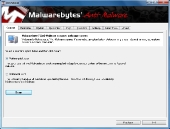I’m Already Infected Help!
OK so you clicked on the window or you have warnings popping up telling you that you are infected. You have been had and you might not even know when or how it happened. The first part of this guide is still important to understand how to avoid this type of infection but we will move on to the removal now that you already have an infection on your PC. NOTE: Be wary of pop up advertisements which claim you are already infected.. you may not be, UNTIL you click on the advertisement to “Scan” your PC.
If you have sought the help of your local computer tech there are a few things you should know right at the start:
- Viruses, malware, and spyware cannot damage your hardware. You may lose your data but your computer itself will work fine after a re-install.
- There are free utilities (software) available online that will do everything you need. So there is no need to purchase any software.
Currently your one stop shop solution to all things Malware and Spyware is Malwarebytes. This program is pure gold for those who need help without having to hack into your registry, dig through endless folders and file names. Install and run the quick scan, let it complete, remove everything it finds, reboot if necessary and repeat. If anything is discovered after a second scan, then you have a more serious problem.
The problem with current malware and spyware is that they know about Malwarebytes and once installed they prevent you from downloading and running the program. The wonderful folks at Malwarebytes have actually accounted for this and developed a version of their program that randomizes the name it downloads as and also randomizes the name that the program runs as the first time. Essentially they are using the malware and spyware programmers tactics against them. You can get this handy program from the following link: Download Here.
There are other programs out there which will assist you with removal and or prevention too, for example Symantec’s Norton and McAfee to name a couple. Though some of the tools have been know to cause so much overhead to slow down your system as bad as the virus or malware your trying to prevent in the first place. We suggest the standard Norton Anti-virus as well as McAfee anti-virus
Another free anti-virus tool out on the internet is Microsoft’s Security Essentials. Found here. This tool is slim and takes up very little overhead, so it won’t affect the performance of your system no matter the age and available resources.
| – Microsoft Security Essentials provides real-time protection for your home PC that guards against viruses, spyware, and other malicious software. – Microsoft Security Essentials is a free* download from Microsoft that is simple to install, easy to use, and always kept up to date so you can be assured your PC is protected by the latest technology. It’s easy to tell if your PC is secure — when you’re green, you’re good. It’s that simple. – Microsoft Security Essentials runs quietly and efficiently in the background so that you are free to use your Windows-based PC the way you want—without interruptions or long computer wait times. |
Developing Events:
As we pointed out earlier malware and spyware can be transmitted to additional computers via external devices with storage. Lately we have seen devices such as iPods, MP3 players, and embedded devices such as phones and camera carrying these infections. One thing is certain, the hackers want your data and money and are very subversive in their means to get it. If you do not become familiar with the tactics used by this growing type of thief you will become a victim. Your local computer repair store, Best Buy Geek Squad, and the Firedog computer repair staff are often not a good solution for your problems. These businesses have been shown in the past to be uninformed and often to use questionable business practices to convince you that you need hardware and software that you do not.
Conclusion:
We intend to keep this article updated as events in the virus, malware, and spyware circles are continually developing. The point of this article should be that you take away the following concepts:
- Read the information presented to you during installations and in pop-ups. Make sure you really want that software that has the check box to also be installed before you automatically click next.
- Knowing what to look for can help prevent 95% of all your problems with malware and spyware. if the message doesn’t come from software already installed on your machine the likelihood is that its trying to trick you into installing something you really don’t want.
- Simple and free software exists to help you out in the case that you have been infected. Don’t pay for hardware and software you don’t need.
- If you are a part of a business or workplace with dedicated IT then you should consult with your IT administrator or Tech support before you decide to click on that pop-up on your screen. Save yourself hours of lost time and IT effort in cleanup afterward.
- If the pop-up, file, download, etc looks fishy then its probably a salmon and you don’t want it swimming in your PC.


Panda internet security is a good company but I tend to trust Kaspersky labs or McAfee more. overall good work Jason.
I welcome comments and additions. This is a work in progress and I intend to keep it updated. If you have information please share.